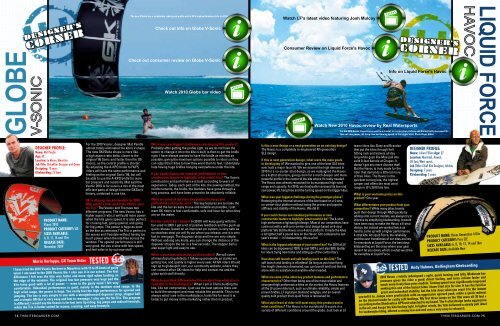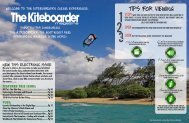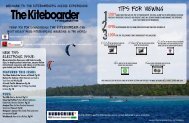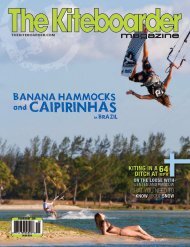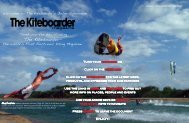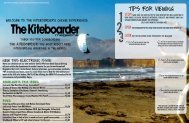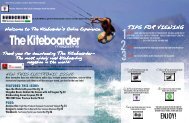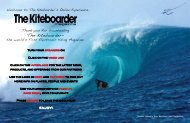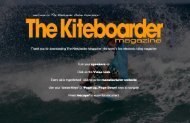December 2009 - The Kiteboarder Magazine
December 2009 - The Kiteboarder Magazine
December 2009 - The Kiteboarder Magazine
Create successful ePaper yourself
Turn your PDF publications into a flip-book with our unique Google optimized e-Paper software.
Globe<br />
designer’s<br />
corner<br />
<strong>The</strong> new VSonic has a completely redesigned profile and is GK’s high performance kite for 2010.<br />
designer’s<br />
corner<br />
For the 2010 Havoc, Liquid Force went to a 4-strtut, no center strut platform and dramatically increased its<br />
low end raw power, lift, hang time and turning speed on the bigger kites. Photo Bryan Elkus<br />
liquid force<br />
Designer Profile:<br />
Name: Mat Pendle<br />
Age: 42<br />
Location: Le Morne, Mauritius<br />
Job Title: GlobeKites Designer and Owner<br />
Designing: 13 years<br />
Kiteboarding: 13 Years<br />
For the 2010 Vsonic, designer Mat Pendle<br />
almost totally eliminated the kite’s V shape.<br />
<strong>The</strong> new GKVDelta shape is more like<br />
a high aspect ratio delta, closer to the<br />
original ‘06 Sonic and faster then the ‘09<br />
Vsonic, as the central profile is shorter.<br />
By adjusting the A-KPO bridle to F4/F5,<br />
riders will have the same performance and<br />
feeling as the original Sonic ‘06, but will<br />
be able to use the A-KPO bridle for more<br />
bar pressure and reactivity. Mat said the<br />
Vsonic 2010 is for sure is a mix of the most<br />
efficient parts of design from the GKSonic<br />
history, combined in one kite.<br />
GK is offering two kite models for 2010.<br />
Why would a rider prefer the VSonic over<br />
the Trix? <strong>The</strong> Vsonic and Trix have two<br />
different programs. <strong>The</strong> new Vsonic has a<br />
higher aspect ratio; it will build more power<br />
when the kite gains speed. It is also perfect<br />
for cruising fast, going upwind, and going<br />
for big jumps. <strong>The</strong> power is huge as soon<br />
as the kite accelerates.<strong>The</strong> Trix is perfect in<br />
the waves and freestyle without having too<br />
much power when the kite flies across the<br />
window. <strong>The</strong> upwind performance is still<br />
very good, but you cruise with less speed,<br />
and feel safer to try out new stuff.<br />
I have tried the 2010 Vsonic 8m here in Mauritius with 15 to 25 knots of gusty<br />
wind. I am used to the <strong>2009</strong> Vsonic 8m. I also use it in our school. <strong>The</strong> first<br />
difference I felt was the kite was faster and more rigid when landing on<br />
the edge of the window. <strong>The</strong> original low bar pressure was kept and the<br />
kite turns good with a lot of power — even in the gusty wind I felt very<br />
comfortable. Unhooked performance is good, mainly in the medium wind range. In the<br />
high wind range, the power is huge. You really feel the high performance for upwind and<br />
jumping. <strong>The</strong> bar is very simple to use with a straightforward depower strap, stopper ball<br />
and a simple QR that is very easy and fast to reengage. I also use the 9m Trix. <strong>The</strong> program<br />
is different; I would say the Vsonic is for fast twin tip riding, big jumps and radical freestyle,<br />
while the Trix is better suited for waves, cruising, and easy freestyle.<br />
74 thekiteboarder.com<br />
Product name:<br />
VSonic 2010<br />
Product category: SLE<br />
Sizes available:<br />
6, 8, 11, 14 and 17m<br />
Release date:<br />
November <strong>2009</strong><br />
Mario Verloppe, GK Team Rider<br />
tested<br />
What was your biggest challenge in developing this product?<br />
Probably after getting the profile right, as we do not have the<br />
option to change it once the kite is built, is then to get the bridle<br />
right. I have always wanted to have the bridle as minimal as<br />
possible, giving the maximum options possible to riders so they<br />
can adjust their kites to how they want them to feel. I absolutely<br />
hate having huge bridles hanging everywhere under the kite.<br />
If you could choose one standout performance or new<br />
construction feature to highlight, what would it be? <strong>The</strong> Vsonic<br />
construction and performance is built according to years of<br />
experience. Today, each part of the kite, the sewing method, the<br />
reinforcements, the bridle, the bladders have gone through a<br />
long process, and have been proved to be absolutely reliable.<br />
What are some of the other key product features and<br />
performance characteristics? <strong>The</strong> key features are to make the<br />
kite and the bar as easy to use and reliable as possible, I just<br />
want GK riders to feel comfortable, safe and have fun when they<br />
are on the water.<br />
Did the control bar change? In 2010 I will keep going with the<br />
bar used in <strong>2009</strong>. I got a lot of positive feedback and the push-up<br />
quick release, based on an improved pin system, is very safe as<br />
no stainless steel pin will fly out when you release, and it is very<br />
fast to reengage. <strong>The</strong> depower strap and line are very simple.<br />
Without undoing any knots, you can change the distance of the<br />
depower strap to the bar in a few seconds. <strong>The</strong> stopper ball is<br />
also super light and easy to use.<br />
What is your warranty policy on this product? We will cover<br />
all manufacturing defects. I follow up personally as claims are<br />
getting low, and quality is higher every year. All GK riders should<br />
sign up to globespirit.com, our community website, where they<br />
can contact other GK riders for help and contact me and the<br />
globe spirit staff directly.<br />
What do you think differentiates this product from what else is<br />
available in the marketplace? When I am in China building the<br />
kite, I do not compromise; I just use the best options there are<br />
to build the strongest and most reliable kite possible. This is not<br />
always what I see in the marketplace, looks like for most it is<br />
better to put money in the marketing rather then in product.<br />
Is this a new design or a next generation on an existing design?<br />
<strong>The</strong> Havoc is a completely re-engineered 4th generation<br />
SLE design.<br />
If this is next generation design, what were the main goals<br />
in developing it? We wanted to give one of the best SLE kites<br />
ever built a major face lift. We envisioned the high demand in<br />
2010 for a no-center-strut design, so we redesigned the Havoc<br />
on a 4-strut structure, giving room for a much deeper and more<br />
powerful profile in the center of the kite where it’s really needed.<br />
<strong>The</strong> Havoc was already renowned for its exceptional high wind<br />
range and capacity. For 2010, we drastically increased its low end<br />
raw power, lift, hang time and the turning speed on the bigger kites.<br />
What was your biggest challenge during the prototype phase?<br />
Redesigning the internal structure of the kite based on a 4 strut,<br />
no-center-strut platform without losing the proven and popular<br />
stiffness and stability of the Havoc. We did it!<br />
If you could choose one standout performance or new<br />
construction feature to highlight, what would it be? <strong>The</strong> 4-strut,<br />
high performance lightweight design. Most of our competitors have<br />
come out with a with a no-center-strut design based on 6-strut<br />
platform: We did the Havoc on a 4-strut platform. It made the kites<br />
a lot lighter; half a pound less on the Havoc 12m compared to last<br />
year’s model — in kiteboarding, this is a lot!<br />
What is the biggest advantage of your control bar? For 2010 all LF<br />
kites can be depowered 100% (a real 100%), and also 90% (better<br />
for riders trying new tricks and letting go of the control bar).<br />
How does self launch and self landing work on this kite? <strong>The</strong><br />
self launch and landing is effortless! As long as you have flying<br />
line length clearance downwind, you can launch and land the kite<br />
alone with no assistance at anytime when needed.<br />
What are some of the other key product features and performance<br />
characteristics? Other then being one of the most reliable and<br />
strongest high performance kites on the market, the Havoc features<br />
all the LF proven kite tech, such as ultimate reliability, simple and<br />
proven bridles, LF signature diamond wingtips, and an overall<br />
quality built product that Liquid Force is renowned for.<br />
What style/level of rider will most enjoy this product and in<br />
what conditions? <strong>The</strong> Havoc is for everybody! It excels in a<br />
variety of different conditions around the globe. Just look at LF<br />
team riders like Slezy and Brandon<br />
that put the kites through hell<br />
hitting rails and kickers all day<br />
long while guys like Moe pull into<br />
solid 8-foot barrels at Chopes. It<br />
doesn’t get any more diverse that!<br />
But the Havoc is truly made for the<br />
rider that demands a little bit more<br />
of their kites. <strong>The</strong> Havoc is the<br />
quickest turning kite, the highest<br />
jumper and offers the most wind<br />
range in LF’s 2010 kite line.<br />
What is your warranty policy on this<br />
product? One year.<br />
What differentiates your product from your<br />
competitors? While many other brands<br />
push their design through R&D quickly by<br />
adding onto current models, we always try to<br />
improve by simplifying kiteboarding. It would<br />
have been easy to make the Havoc a 6-strut<br />
design, but instead we worked twice as<br />
hard to come up with a higher performance<br />
4-strut kite. At Liquid Force, the reliability<br />
and the over friendliness of our kites are key.<br />
To everybody at Liquid Force, the best days<br />
kiteboarding are the ones where your gear<br />
doesn’t let you down, which is what we strive<br />
for everyday at Liquid Force.<br />
tested<br />
Designer Profile:<br />
Name: Julien Fillion Age: 27<br />
Location: Montréal, Hawaii,<br />
US East/West coasts<br />
Job Title: Chief Kite Designer, Athlete<br />
Designing: 7 years<br />
Kiteboarding: 5 years<br />
Product name: Havoc Generation 4 Kite<br />
Product category: Pure SLE<br />
Sizes available: 6, 8, 10, 12, 14 and 16m<br />
Release date: Available Now<br />
Andy Holmes, Bellingham Kiteboarding<br />
2010 Havoc = totally redesigned = agile, quick turning, and lofty. Moderate bar<br />
pressure gives the rider a good, direct feeling, and turns initiate faster and<br />
much more lively than prior models. Turning speed was significantly improved<br />
making this one of the fastest kites I have tried size for size. It has the familiar<br />
grunt and unhooked stability, but the kite does what you want it to the instant<br />
you tell it to. Jumps were predictable with an aggressive upward yank, while a quick redirect<br />
on the descent made for cushy soft landings. My first three jumps on the 10m were all 30 feet +<br />
according to the Shadowbox GPS unit attached to my board. <strong>The</strong> 4-strut design looks aggressive<br />
in the air, and keeps the kite feeling light. In lighter winds, the 12m delivered a steady pull ideal<br />
for wakestyle riding, offered a strong low end and was a very easy to relaunch.<br />
thekiteboarder.com 75


